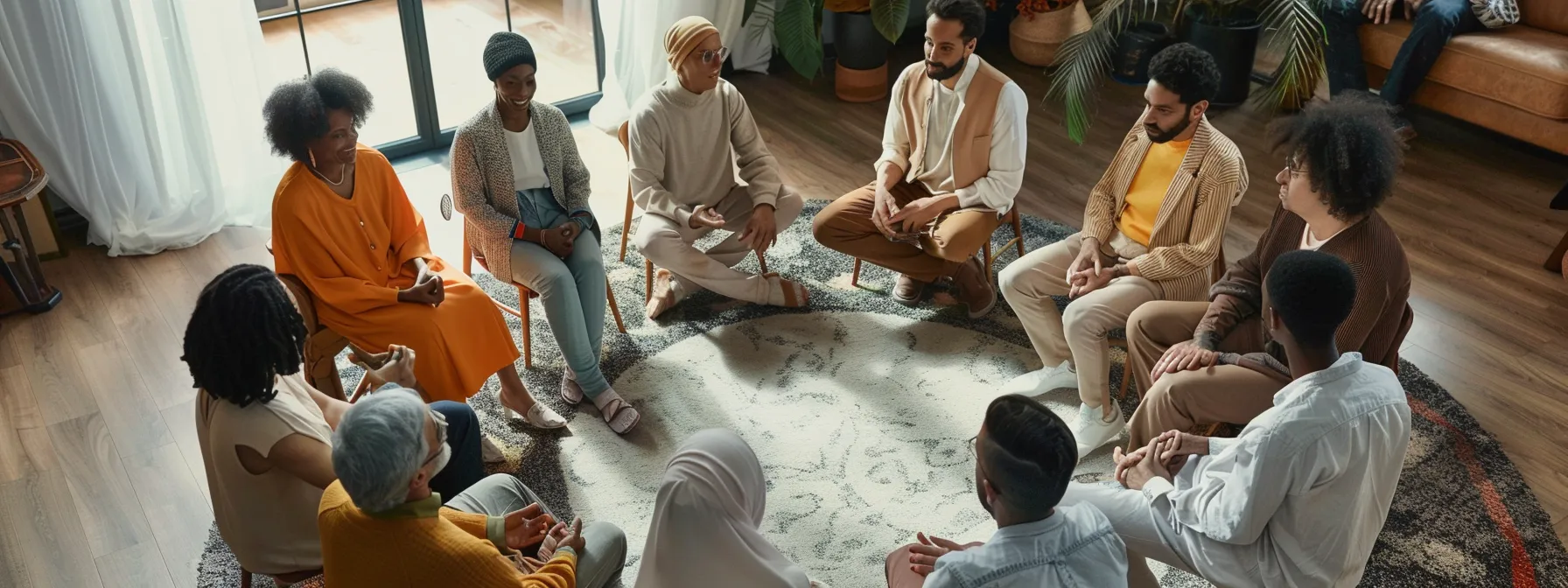Disclaimer: We sometimes use affiliate links in our content. For more information, visit our Disclaimer Page.
Have you ever felt misunderstood during a conversation with someone from a different culture? Understanding intercultural conflict resolution is essential in our diverse world. This article will explore key strategies for resolving conflicts, recognize cultural biases, and develop effective communication skills. By mastering these concepts, you’ll improve your conflict management abilities and navigate various social settings more confidently. Whether you’re dealing with diverse demography in the workplace or enhancing your personal relationships, these insights will help you address misunderstandings and build meaningful connections.
Key Takeaways
- cultural awareness enhances communication and reduces misunderstandings in diverse environments
- adapting to different communication styles fosters trust and collaboration
- effective conflict resolution involves recognizing personal biases and overcoming stereotypes
- practicing active listening is key to understanding diverse perspectives
- ongoing cultural competence training promotes inclusivity and strengthens workplace relationships
Understanding the Importance of Intercultural Conflict Resolution

Cultural differences can significantly impact communication, often leading to misunderstandings. In this section, you will explore common sources of intercultural conflicts, focusing on the effects of individualistic cultures versus collective ones. You will also learn about the benefits of applying cultural sensitivity in leadership to effectively resolve these conflicts and foster better collaboration.
The Impact of Cultural Differences on Communication
Cultural differences can deeply affect how you communicate, leading to misunderstandings that hinder cooperation. Individualistic cultures tend to prioritize personal goals over group objectives, while collective cultures emphasize group harmony. This distinction can create emotional friction where one side sees communication as a chance to innovate and assert independence, and the other views it as a means to maintain cooperative relationships. Understanding these perspectives is essential in navigating conflicts, as it allows you to identify where compromise is possible.
To enhance your social skills across cultures, it’s crucial to engage actively in learning about different communication styles. For example, if you find yourself in a situation where your ideas clash with those from a collective culture, try to listen more and understand their emotional responses. This approach fosters trust and open dialogue. By recognizing how cultural differences impact communication, you can develop strategies that create a more effective and collaborative environment:
- Recognize the distinctions between individualistic and collective cultures.
- Practice active listening to build trust.
- Seek common ground that encourages compromise.
Common Sources of Intercultural Conflicts
Intercultural conflicts often arise from differing societal values that shape individual identities. For example, when navigating cross-cultural interactions, you may encounter challenges rooted in face negotiation theory, which explains how people from various cultures approach conflict resolution. In societies that prioritize harmony, you might find more indirect communication, while in those that value self-assertion, directness is frequently favored. Recognizing these differences is key to developing your conflict resolution skills, as it helps you tailor your approach based on the expectations of the individuals involved.
The communication styles influenced by individual and collective identities can lead to misunderstandings in intercultural settings. When you engage with someone from a culture that emphasizes group harmony, your tendency to focus on personal viewpoints may create friction. To foster healthier relationships and resolve conflicts, you should adapt your communication strategies. By prioritizing a more inclusive approach that respects varying perspectives, you enhance your ability to bridge cultural gaps and find shared solutions.
Benefits of Effective Intercultural Conflict Resolution
Effective intercultural conflict resolution offers numerous benefits that enhance communication and collaboration. By developing your knowledge of nonverbal communication styles across different cultures, you improve your ability to engage with diverse individuals. This understanding can make a significant difference in negotiation settings by allowing you to read behavioral cues that may not be verbally expressed, enabling you to address issues more effectively.
Additionally, the problem-solving skills you gain through mastering intercultural conflict resolution empower you to create inclusive environments. By recognizing and respecting cultural differences, you cultivate a sense of trust and openness. This not only resolves current conflicts but also establishes a foundation for future interactions. Considering these strategies can lead to a more harmonious workplace and stronger relationships:
- Enhance knowledge of nonverbal communication styles.
- Improve negotiation techniques by understanding cultural behaviors.
- Strengthen problem-solving skills for inclusive environments.
Conflict often springs from unseen biases. Understanding these biases and stereotypes can help us bridge the gap between cultures and resolve misunderstandings.
Recognizing Cultural Biases and Stereotypes

Identifying personal biases in your interactions is the first step toward effective intercultural conflict resolution. Recognizing how your worldview, including your views on religion and social organization, can influence your perceptions helps overcome stereotypes that may hinder understanding. By encouraging open-mindedness in diverse settings, you create space for constructive conversations that foster collaboration and mutual respect.
Identifying Personal Biases in Interactions
To effectively engage in intercultural conflict resolution, you must first identify your personal biases. This awareness helps you recognize how your beliefs, particularly about politics and societal norms, shape your reactions in dialogue with others. For instance, if you hold a strong viewpoint about a particular political ideology, it might affect your willingness to consider alternative perspectives during conflicts. Acknowledging these biases allows you to approach conversations with a more open mind.
Utilizing tools like a conflict style inventory can further enhance your understanding of how personal biases influence your conflict resolution style. By assessing your default responses to conflict, you can pinpoint areas where biases may arise, leading to misunderstandings. This proactive approach not only improves your ability to manage conflicts but also fosters a deeper connection with individuals from diverse backgrounds, paving the way for cooperative dialogue and mutual respect.
Overcoming Stereotypes to Foster Understanding
Overcoming stereotypes is essential for effective intercultural communication and resolution. By acknowledging the value that diversity brings, you can start to break down preconceived notions based on gender, ethnicity, or cultural background. Engaging in open dialogues with individuals from different cultures allows you to challenge your assumptions and find common ground, ultimately fostering a deeper understanding of their experiences and perspectives.
When you actively work to dispel stereotypes, you reduce the potential for cultural conflict. Practicing empathy is key; consider how your perceptions may influence your interactions. For instance, rather than relying on generalizations, ask specific questions about someone’s cultural practices or beliefs. This approach not only builds trust but also enriches your understanding of the unique values that shape intercultural relationships, paving the way for more effective conflict resolution.
Encouraging Open-Mindedness in Diverse Settings
Encouraging open-mindedness in diverse settings is essential for successful interpersonal communication, especially in today’s era of globalization. By fostering an environment where differing perspectives are not only acknowledged but welcomed, individuals can engage in more meaningful dialogues. This approach not only mitigates biases rooted in individualism but also enhances the ethics of interaction, guiding participants toward shared understanding and effective mediation strategies.
To cultivate open-mindedness, actively seek opportunities to engage with individuals from varied backgrounds. For instance, participate in workshops focused on intercultural communication that challenge your preconceived notions. Creating a dialogue around ethics and diversity allows for richer interactions, improving your ability to navigate conflicts and find common solutions:
- Welcome diverse perspectives in discussions.
- Foster workshops that teach cultural empathy.
- Encourage questions to deepen understanding.
Cultural biases shape our understanding, but they don’t have to define it. Developing essential intercultural communication skills allows you to connect meaningfully with others, breaking down barriers along the way.
Developing Essential Intercultural Communication Skills

Active listening techniques across cultures are crucial for enhancing communication within your organization. You will learn about verbal and non-verbal communication differences that impact understanding and can lead to conflicts of interest. Additionally, building empathy and cultural sensitivity can significantly improve interpersonal interactions, fostering effective conflict resolution strategies and promoting a harmonious workplace environment.
Active Listening Techniques Across Cultures
Active listening is a vital skill for fostering collaboration in intercultural settings. By paying close attention to verbal and non-verbal cues, you can better navigate the nuances of communication that differ across cultures. Research indicates that understanding body language and tone can significantly enhance cognition and lead to more meaningful interactions. In practice, this means reflecting back what you’ve heard and asking clarifying questions, ensuring you grasp the speaker’s intent without making assumptions.
Emphasizing empathy during conversations with diverse individuals promotes an inclusive atmosphere. For example, when speaking with colleagues from different backgrounds, you can acknowledge their experiences and validate their feelings. This approach not only facilitates conflict resolution but also encourages open dialogue. By incorporating these active listening techniques, you will create a supportive environment where everyone feels heard and respected:
Verbal and Non-Verbal Communication Differences
Understanding verbal and non-verbal communication differences is vital for effective conflict resolution across cultures. For instance, certain cultures may favor direct communication, where straightforwardness is valued, while others may utilize indirect methods, focusing on context and relationship preservation. This contrast can present a risk during interactions, as your bias towards one style may lead to misunderstandings and hinder collaboration.
The dimension of non-verbal cues, such as body language and facial expressions, also plays a significant role in how messages are conveyed. In some cultures, maintaining eye contact is a sign of confidence, while in others, it may be viewed as disrespectful. Being aware of these nuances will not only enhance your understanding of diverse cultures but also improve your ability to navigate potential conflicts with greater sensitivity and respect.
Building Empathy and Cultural Sensitivity
Building empathy and cultural sensitivity in a multicultural workplace is crucial for reducing interpersonal conflicts. By paying close attention to the diverse perspectives of your colleagues, you can minimize aggression and foster a more inclusive environment. For example, actively seek feedback from team members about their experiences and opinions, which can illuminate differing viewpoints and enhance mutual respect.
Additionally, implementing training sessions focused on cultural awareness can significantly improve relationships among diverse teams. Providing tools for your employees to engage with various cultural backgrounds enables better communication and understanding. Such initiatives not only decrease the likelihood of misunderstandings but also promote a workplace culture where everyone feels valued and heard:
With skills in intercultural communication, you can better understand others. Yet, when differences arise, knowing how to resolve those conflicts becomes crucial.
Strategies for Resolving Intercultural Conflicts

To effectively resolve intercultural conflicts, consider implementing mediation and facilitation methods that encourage open dialogue. Collaborative problem-solving approaches can also help bridge cultural gaps by focusing on shared goals. Additionally, applying conflict resolution models tailored for intercultural contexts allows you to navigate differences with greater ease. Each of these strategies plays a vital role in fostering understanding and cooperation.
Implementing Mediation and Facilitation Methods
Implementing mediation and facilitation methods is essential for effectively handling intercultural conflicts. When you serve as a mediator, you create a space where all parties can share their perspectives without interruption. This approach not only ensures that everyone feels heard but also helps to clarify misunderstandings and build mutual respect, which is vital in diverse environments.
Facilitation, particularly in group settings, encourages collaborative discussions aimed at finding common ground. It is important to guide conversations in a way that addresses cultural sensitivities while keeping the focus on shared goals. By using structured methods such as guided questions or consensus-building techniques, you enhance the chances of reaching an amicable resolution and fostering a more cohesive environment.
Collaborative Problem-Solving Approaches
Collaborative problem-solving approaches are essential for effectively resolving intercultural conflicts. By encouraging all parties involved to share their perspectives and experiences, you create a sense of ownership in the resolution process. This method not only fosters mutual respect but also helps uncover underlying issues that may not be apparent at first glance, leading to more sustainable solutions. For instance, if you find yourself facing a disagreement with colleagues from different cultural backgrounds, working together to identify common goals can transform the conflict into an opportunity for growth and understanding.
Applying collaborative problem-solving techniques requires active participation from everyone involved. You may choose to facilitate brainstorming sessions that allow each person to propose solutions, ensuring that cultural sensitivities are considered in the dialogue. This approach not only enhances creativity but also strengthens relationships as participants feel valued and heard. Ultimately, by focusing on collaboration, you empower individuals to work through conflicts constructively, paving the way for a more cohesive and productive environment.
Applying Conflict Resolution Models in Intercultural Contexts
Applying conflict resolution models in intercultural contexts requires an understanding of varying cultural norms and values. When addressing conflicts, you should consider models such as the Interest-Based Relational approach, which emphasizes maintaining relationships while exploring each party’s interests. This method encourages you to create solutions that satisfy both sides, enhancing collaboration and mitigating misunderstandings.
Additionally, utilizing the Thomas-Kilmann Conflict Mode Instrument can help you identify your and others’ conflict resolution styles, promoting better communication. For example, if you recognize that a colleague prefers a collaborative approach, you can adapt your strategies to promote a productive dialogue. By effectively employing these conflict resolution models, you can transform potential disputes into opportunities for growth and understanding across cultures.
Understanding the methods to resolve intercultural conflicts is just the beginning. Now, let’s look at real stories where these strategies made a difference.
Case Studies of Successful Intercultural Conflict Resolution

In this section, you will examine real-world case studies that highlight successful intercultural conflict resolution. You will learn valuable lessons from these situations, analyze the effective strategies used, and understand how to adapt these techniques to different cultural environments. These insights will reinforce your ability to bridge cultural gaps and foster effective communication.
Lessons Learned From Real-World Situations
Successful intercultural conflict resolution often provides valuable lessons that you can apply in your own experiences. For instance, a case involving an American company working with a Japanese partner highlighted the need for patience and careful listening. When misunderstandings arose from differing communication styles, both sides learned that addressing issues through collaborative discussions led to creative solutions, reinforcing the importance of adapting your approach based on cultural context.
Another impactful situation occurred during negotiations between a German and a Brazilian firm, where the directness of the German team initially caused discomfort. By recognizing this cultural difference, they adjusted their communication style to be more relationship-focused, ultimately fostering trust and collaboration. These situations exemplify how awareness of cultural dynamics not only resolves conflicts but also strengthens partnerships, leading to improved outcomes:
- American company and Japanese partner: Emphasis on patience and listening.
- German and Brazilian firms: Adaptation of communication styles to build trust.
Analyzing Effective Strategies Used
When analyzing effective strategies from successful intercultural conflict resolution cases, you can observe the importance of flexibility in communication styles. For instance, adapting your approach based on your counterpart’s cultural preferences can significantly enhance mutual understanding. In one case, a team learned to modify their direct negotiation tactics to align better with their partners’ more relationship-oriented style, which ultimately led to a successful agreement and a stronger partnership.
Furthermore, fostering a culture of open dialogue plays a vital role in resolving conflicts. In several instances, including multinational partnerships, creating a safe environment for all parties to express their perspectives encouraged transparency and trust. By asking open-ended questions and demonstrating active listening, you can facilitate deeper discussions that lead to shared solutions, paving the way for long-lasting collaboration across cultures.
Adapting Techniques to Various Cultural Environments
When faced with intercultural conflicts, adapting your techniques to various cultural environments is essential for fostering successful resolutions. For instance, if you are collaborating with partners from high-context cultures, where indirect communication is preferred, you might need to be more attuned to subtle cues and non-verbal signals. By being flexible in your approach, you can cultivate a respectful dialogue that bridges the gap between different communication styles, demonstrating your commitment to understanding their cultural framework.
Real-life experiences often illustrate that adapting your conflict resolution tactics can yield significant improvements in communication. For instance, you may find that a direct negotiation style works well in individualistic cultures, while a more relationship-focused method is critical in collectivist settings. By actively assessing the cultural context of the situation, you can tailor your interactions to promote a more inclusive atmosphere, ultimately enhancing collaboration and reducing potential misunderstandings.
The stories of resolution show us what is possible when cultures meet. As we learn from these successes, the journey of cultural competence must continue, shaping our interactions and understanding day by day.
Promoting Ongoing Cultural Competence and Learning

To effectively bridge cultures, it’s vital to promote ongoing cultural competence and learning. This involves investing in cultural education and training, which equips you with the necessary skills to navigate diverse environments. Additionally, encouraging inclusive practices in organizations fosters collaboration, while sustaining positive intercultural relationships ensures fruitful interactions. Each of these aspects plays a critical role in mastering intercultural conflict resolution strategies.
Investing in Cultural Education and Training
Investing in cultural education and training is crucial for enhancing your ability to navigate intercultural conflicts. This investment equips you with the skills necessary to understand diverse cultural perspectives and communication styles. For instance, participating in workshops that focus on cultural norms can help you grasp how to approach conflicts more effectively, leading to stronger relationships in the workplace.
Moreover, organizations that foster ongoing cultural competence create a more inclusive environment where everyone feels respected. By implementing training programs that discuss cultural sensitivity, you reduce the likelihood of misunderstandings. To visualize the benefits of investing in cultural education, consider the following table that outlines key outcomes:
Encouraging Inclusive Practices in Organizations
Encouraging inclusive practices in your organization is vital for fostering a culture that values diversity. By implementing team-building activities that celebrate different cultural backgrounds, you create an environment where everyone feels valued and heard. This not only enhances team cohesion but also helps to bridge communication gaps, reducing the potential for misunderstandings that may arise from cultural differences.
Additionally, promoting open dialogue about cultural experiences can significantly improve intercultural interactions. Providing platforms for employees to share their backgrounds and perspectives encourages empathy and broadens understanding. This proactive approach not only strengthens workplace relationships but also empowers individuals to collaborate more effectively, leading to successful conflict resolution in diverse settings.
Sustaining Positive Intercultural Relationships
Sustaining positive intercultural relationships is essential for ensuring effective communication and collaboration in diverse environments. You can achieve this by consistently engaging in open dialogue with colleagues from different backgrounds. Take the time to understand their perspectives and experiences, which fosters trust and creates a supportive atmosphere where everyone feels valued. This approach not only resolves potential conflicts but also strengthens professional ties, allowing for greater cooperation across cultural boundaries.
Additionally, actively participating in cultural exchange activities can help you maintain positive relationships. For instance, consider organizing team events that celebrate various cultural traditions or cuisines. These experiences not only deepen your understanding of different cultures but also promote camaraderie among team members. By prioritizing these interactions, you help build a workplace culture that values diversity and enhances overall collaboration, ultimately leading to more effective conflict resolution strategies.
Conclusion
Mastering intercultural conflict resolution strategies is vital for fostering effective communication and collaboration across diverse cultures. By understanding cultural differences, recognizing personal biases, and developing essential skills like active listening, you enhance your ability to navigate conflicts productively. Engaging in ongoing cultural education and promoting inclusive practices further strengthens relationships and fosters an environment of mutual respect. Ultimately, bridging cultural gaps empowers you to resolve conflicts and build cohesive teams, ensuring success in today’s globalized interactions.





